Kathmandu: Industrialists have decided not to pay the first installment of their outstanding dues related to dedicated trunk line charges.
On Sunday, Acting President of the Federation of Nepalese Chambers of Commerce and Industry (FNCCI) Anjan Shrestha and Director General Gokarna Awasthi met Energy Minister Kulman Ghising and urged him to help resolve the ongoing dispute over the dedicated trunk line bills. During the meeting, Minister Ghising expressed his willingness to remain flexible in finding a solution.
The FNCCI had earlier asked industrialists to hold internal discussions and come up with possible solutions to the dispute. Following this, industrialists involved in the dedicated trunk line issue held a meeting.
In the discussion, most industrialists expressed the view that even for paying the first installment, they would need evidence supporting the billing. They also stated that the earlier bills issued by the Nepal Electricity Authority (NEA) were fabricated, and that they could not make any payment until the fake bills were withdrawn and new, legitimate ones were issued.
After reaching a consensus on this point, the industrialists rejected NEA’s warning — issued on September 27 giving 21 days’ notice to clear dues by October 18 or face power disconnection — and decided not to pay the first installment.
According to NEA’s notice, the industrialists were required to pay the first installment and submit an application by Sunday, since Monday is a public holiday. However, most industries did not submit any such application within office hours.
NEA has said that power supply will be disconnected for those industries that fail to make payments within the deadline.
Acting FNCCI President Shrestha had proposed that the first installment be paid only after NEA accepts certain conditions — such as extending the installment facility, reviewing the dues, and allowing legal recourse. Minister Ghising had reportedly agreed that a solution could be reached through dialogue with the concerned industrialists. Nonetheless, the industries have refused to pay the first installment without justifiable cause.
What is the dedicated trunk line dispute?
Kulman Ghising, during his previous tenure at NEA, had issued arbitrary bills for “dedicated” and “trunk” power lines. Industrialists claim that NEA, under Ghising’s leadership, sent inflated bills for electricity supposedly consumed through these lines — adding premium charges. When industrialists demanded proof that they actually received power as per the billed conditions, NEA failed to provide any evidence. Despite this, Ghising received public praise for his firm actions. He maintains that around NPR 22 billion is still to be collected from dozens of industries under this head.
Industrialists argue that they should only pay premium charges if they received electricity under the terms set by the Electricity Tariff Fixation Commission. On 8 January 2024, the then government led by Pushpa Kamal Dahal formed a commission under former judge Girish Chandra Lal Yadav to study the matter. The commission recommended collecting dues based on “Time of the Day” (ToD) metering data. The Oli government later instructed NEA to implement this recommendation — but it has not yet been enforced.
Industrialists have already filed for a review of the dispute under NEA’s “Review Committee,” having deposited 5 percent of the claimed amount as a bank guarantee. This committee has the legal authority to decide whether the dues should be collected or not. If industries are unsatisfied with its decision, they can then approach the courts — the proper legal procedure for resolving the issue.
NEA had extended the payment facility up to 56 installments, and many industrialists had already applied for review. However, the committee, chaired by NEA’s managing director, has yet to issue any decision.
The courts have refused to grant stay orders to industries that bypassed the review process. According to the Electricity Revenue Collection Regulations, 2016, NEA has no authority to increase rates on previously settled bills. Still, both parties can resolve the issue by mutually agreeing on a new rate through negotiation.
The NEA’s Electricity Distribution Regulations, 2012 state that a review decision should be made within 35 days of filing. Both the High Court and the Supreme Court have emphasized that the review committee must decide before the matter proceeds further.
Despite this, Minister Ghising — immediately after assuming office on September 15 — signed a decision to collect the outstanding dues for dedicated feeders and trunk lines. On September 26, he went further by dissolving the very review committee responsible for deciding the case, putting pressure on it in the process.
Many in the public perceive this dispute as industries refusing to pay their electricity bills. In reality, the controversy is not about unpaid regular electricity bills but about whether “premium charges” should apply.
NEA had issued regular bills, which industries paid on time, even receiving a 2 percent discount for prompt payment.
So how did the arrears dispute arise? The issue lies not in how much power was consumed, but in what rate per unit should be charged.
Background of the premium charge dispute
Load-shedding (scheduled power cuts) began in Nepal in 2005. As demand grew faster than supply, NEA introduced power rationing. In 2012, the government decided to provide uninterrupted power supply to essential services — such as security agencies, hospitals, Singha Durbar, telecoms, water supply, and airports — via direct connections from substations.
When NEA’s losses increased due to the growing load-shedding, it decided to introduce a “premium charge” for industrial and commercial consumers who received uninterrupted power during blackout hours.
On 26 June 2015, NEA’s board decided to impose additional charges on customers using dedicated feeders starting 17 July 2015.
However, the Electricity Act gives the right to approve any tariff only to the then Electricity Tariff Fixation Commission. The Lal Commission later concluded that NEA could not legally impose such charges on its own.
The commission on 13 January 2016 allowed NEA to charge premium rates only if customers received a full 24-hour power supply. Based on this, the government decided to apply premium charges only from February 2016.
The dispute over whether premium charges should apply between July 2015 and January 2016 was settled by a Cabinet decision.
The current dispute concerns the period from February 2016 to April 2018: whether the premium tariff applies to that entire period or only if the NEA met the commission’s service conditions.
NEA agrees that after load-shedding ended in May 2018, no premium charges should apply.
Industrialists argue that premium rates should only apply when 24-hour uninterrupted electricity was provided through dedicated lines starting from February 2016.
They are demanding that NEA provide proof — based on ToD (Time of Day) metering — that they actually received continuous 24-hour power (for dedicated lines) or at least 20 hours of power during 6-hour load-shedding (for trunk lines).
NEA has so far failed to provide such evidence.
For dedicated lines, the dispute dates back to February 2016, and for trunk lines, it began in July 2016. NEA sent the disputed bills only in March 2019, four years later, adding premium charges.
Industries claim they never received 20-hour continuous supply and therefore should not be billed at premium rates. NEA has not published ToD data that could prove otherwise.
The Electricity Tariff Fixation Commission had clearly stated that premium rates could only apply under specific conditions — which NEA has not proven.
Industrialists argue that if they had indeed received uninterrupted power during load-shedding, NEA should have issued premium bills back then — not four years later.
They accuse NEA of misleading the public into thinking industries avoided paying their bills. “We have paid all our regular bills,” industrialists said. “The dispute is only about the premium tariff. Without proof that the commission’s conditions were met, how can NEA demand premium payment?”
In 2019, NEA issued “arrear adjustment bills” including premium rates. But according to NEA’s own 2016 revenue regulations, such adjustments are only allowed for excess electricity consumption, not for altering tariff rates.
Even though the bills were issued after four years, industrialists say they are willing to pay under premium rates if NEA provides evidence that they received uninterrupted electricity supply — 24 hours in the case of dedicated lines, and 20 hours during 6-hour load-shedding in the case of trunk lines.
Currently, NEA claims industries owe Rs 6.6 billion for the period between February 2016 and April 2018 but has failed to provide proof to support this claim.
Industries also point out that NEA wrongly billed trunk line users from February 2016, even though trunk line services only began in July 2016.
Thus, the current dispute is not about how much electricity was used, but about which days and under what conditions premium rates should apply.



Comment Here